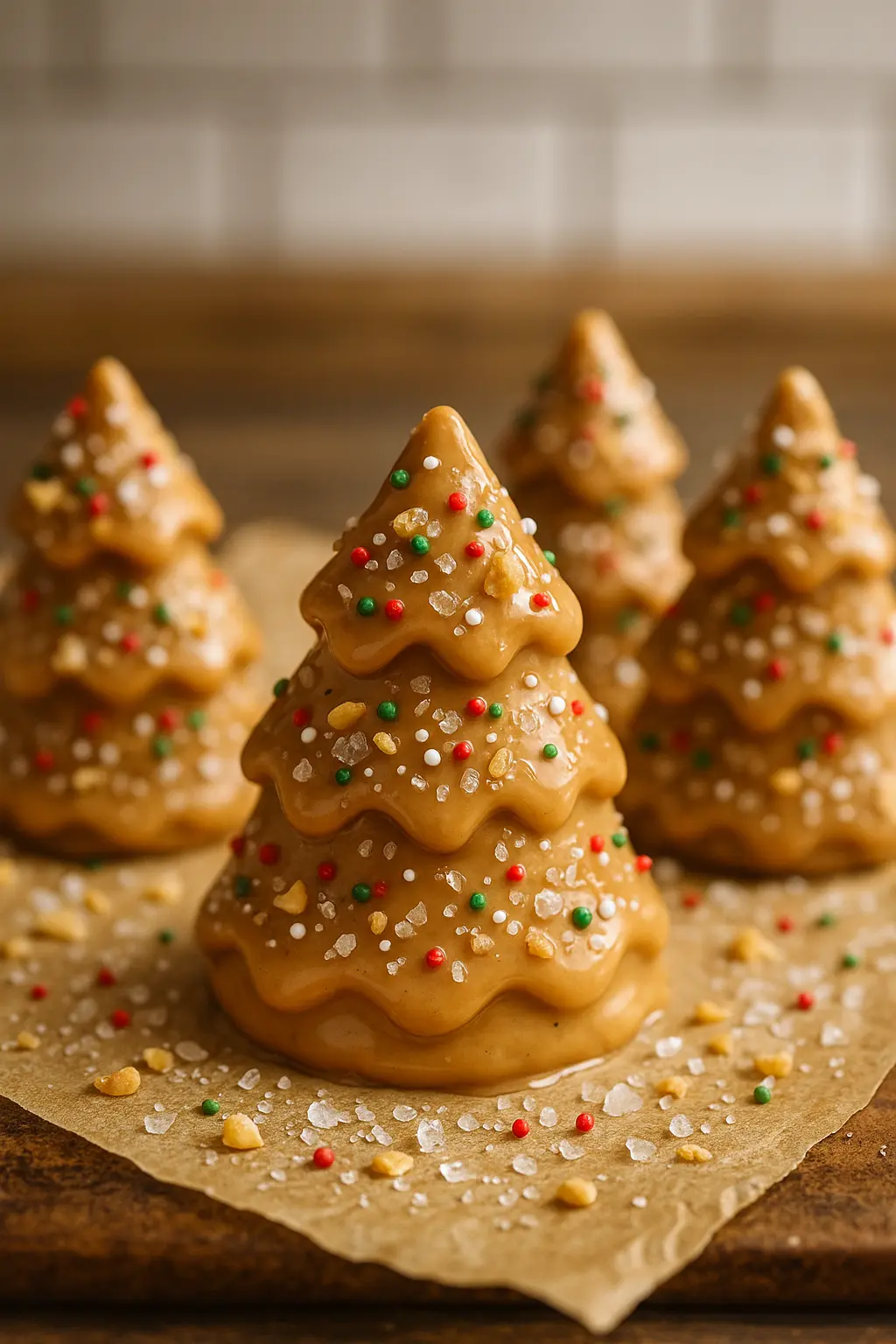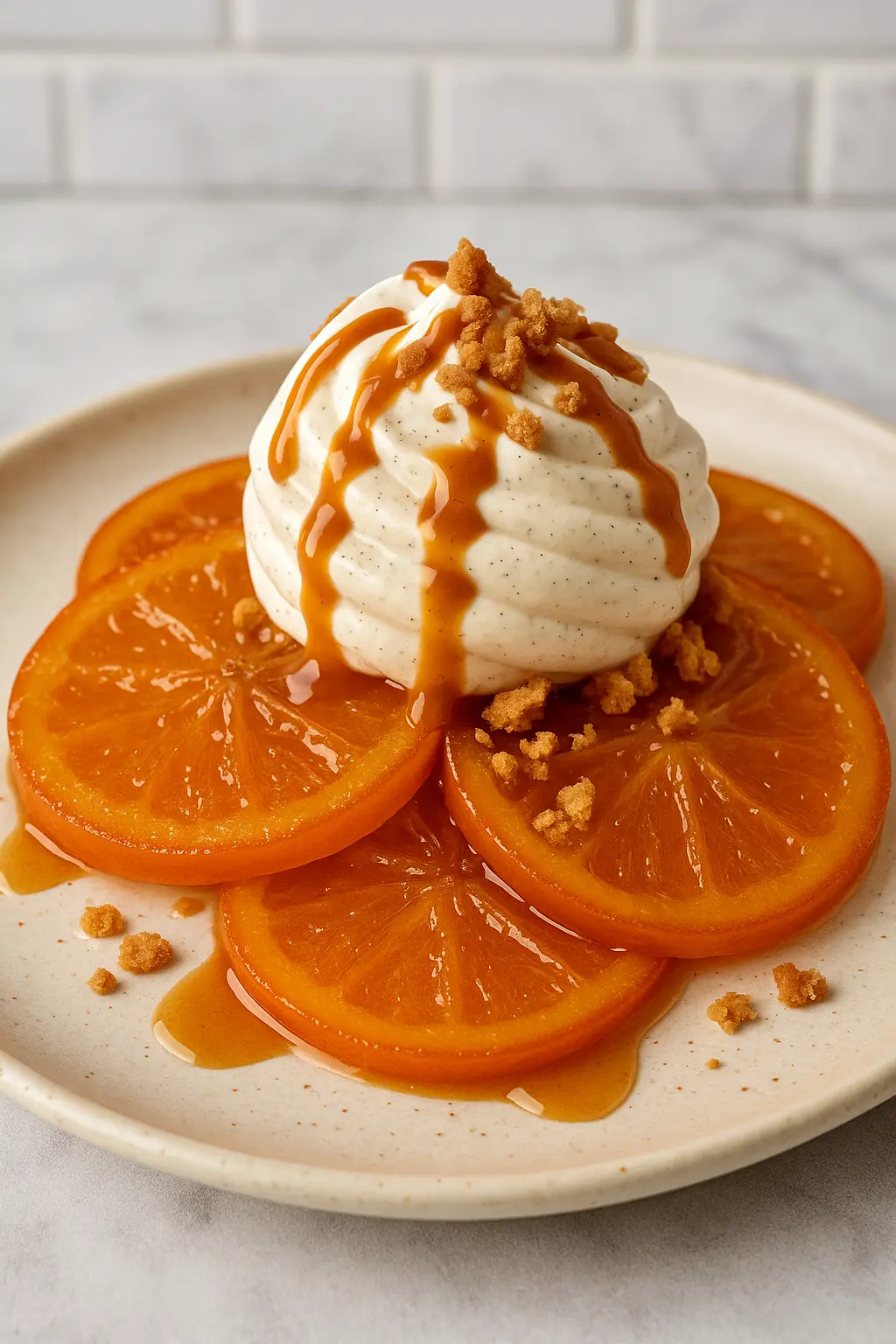The Best Roasted Butternut Squash Recipe for All Seasons (Serves 6)
There’s something incredibly comforting about roasted butternut squash. Whether it’s a chilly winter night or a breezy summer evening, this versatile dish never fails to satisfy. I remember learning to roast butternut squash with my grandmother on a quiet fall afternoon. Her method was simple. Just a few ingredients, a hot oven, and lots of love. Over time, I’ve adapted her method to fit a modern, health-conscious kitchen while retaining that rustic, caramelized flavor that made it so special.
Today, I’ll share with you a perfected version of this timeless recipe, fit for both winter feasts and summer BBQs. Whether served as a side dish, a salad base, or even a main course with toppings, roasted butternut squash deserves a spot in your kitchen repertoire.
Roasted butternut squash is not only rich in flavor but also loaded with nutrients. It’s packed with vitamin A, vitamin C, potassium, and fiber, making it a powerhouse ingredient perfect for both cozy comfort food and light summer dishes. When roasted, its natural sugars caramelize, creating a beautifully sweet, slightly nutty flavor with a crisp exterior and soft, velvety center.
Whether you’re preparing roasted butternut squash for a weeknight dinner or a festive gathering, this recipe keeps things simple, flavorful, and wholesome.
Ingredients
To serve 6 people:
- 1 large roasted butternut squash (about 2½ to 3 pounds)
- 2 tablespoons olive oil
- 1 teaspoon sea salt
- ½ teaspoon freshly ground black pepper
- 1 teaspoon garlic powder (optional for extra depth)
- ½ teaspoon ground cinnamon (adds a touch of warmth)
- 1 tablespoon maple syrup (optional, for winter flair)
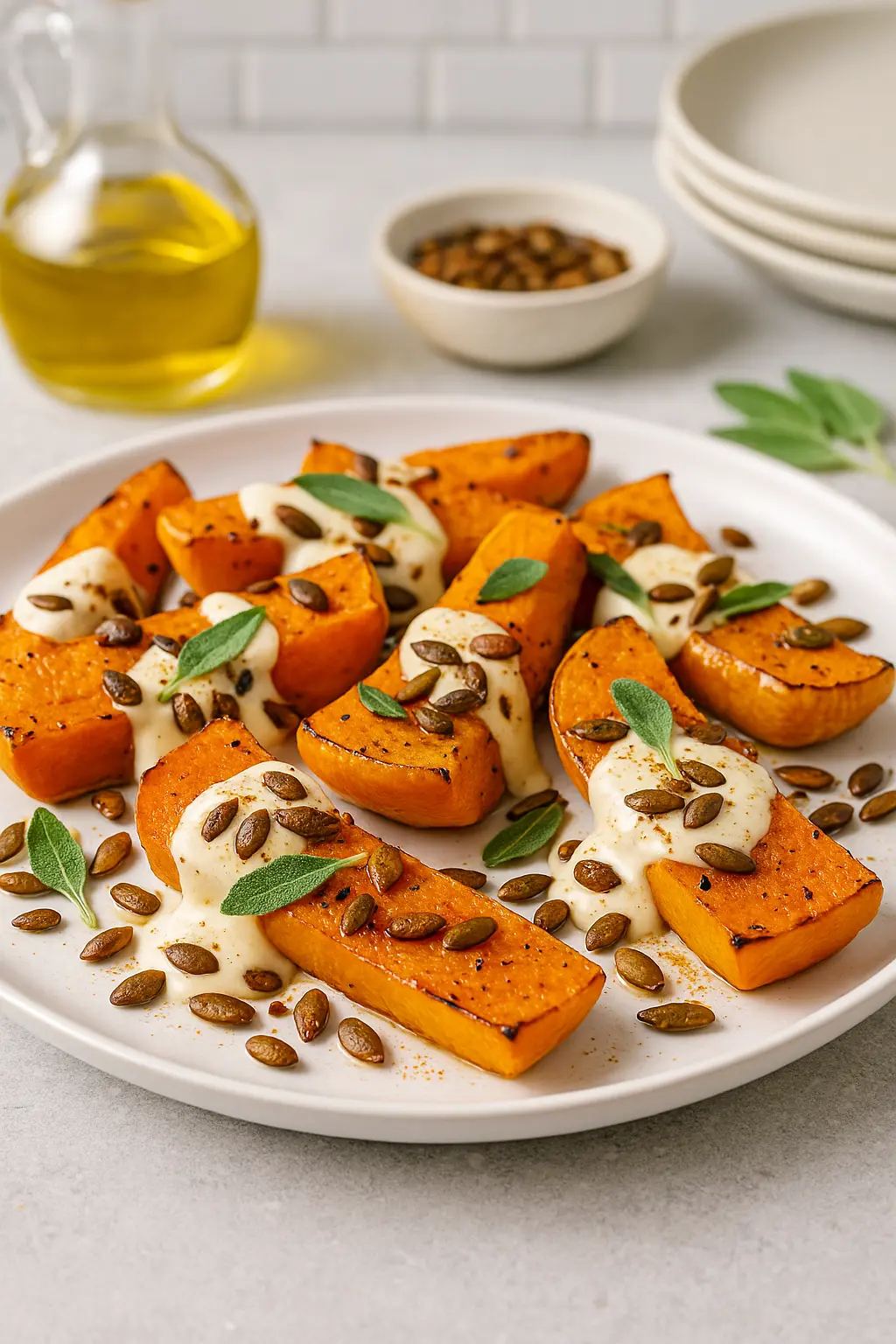
Optional Garnishes (seasonal inspiration):
- Summer: fresh basil, feta cheese, toasted pine nuts
- Winter: pomegranate seeds, chopped pecans, tahini drizzle
Instructions
Prepare the Squash
Preheat your oven to 400°F (200°C). Peel the roasted butternut squash using a vegetable peeler. Slice it in half, remove the seeds, and then cut it into 1-inch cubes. This size ensures even roasting and beautiful caramelization.
Season and Toss
Place the cubes in a large bowl. Add olive oil, salt, pepper, garlic powder, and cinnamon. If you’re making a winter version of roasted butternut squash, drizzle with maple syrup. Toss until every cube is coated evenly.
Roast to Perfection
Spread the seasoned cubes in a single layer on a baking sheet lined with parchment paper. Avoid overcrowding. Roast for 25 to 30 minutes, flipping halfway through, until the roasted butternut squash is golden, tender, and slightly crisp on the edges.
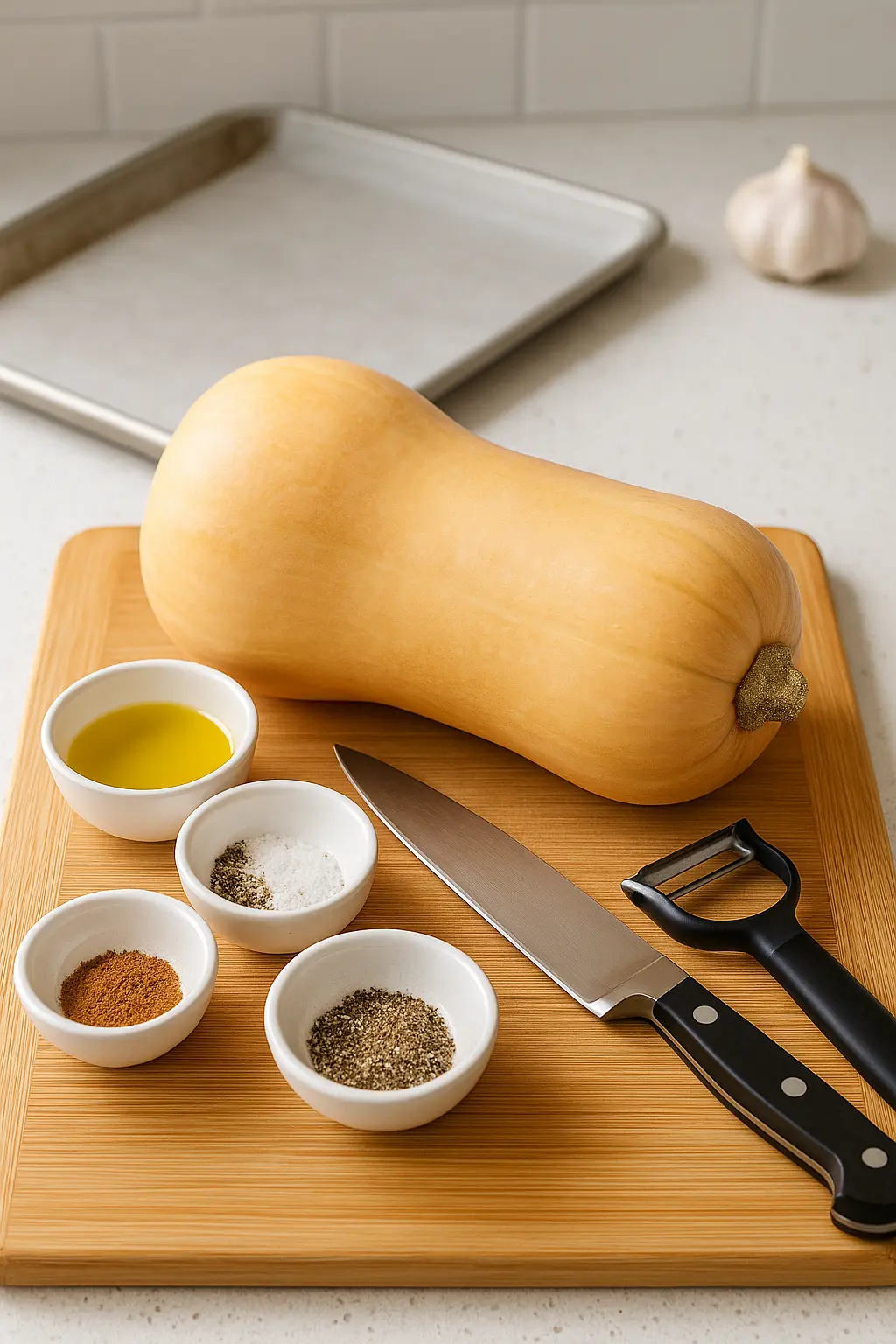
How to Serve Roasted Butternut Squash
In summer, roasted butternut squash pairs beautifully with lighter dishes. Serve it over quinoa with arugula, cherry tomatoes, and avocado for a refreshing grain bowl. It also works wonderfully as a taco filling, especially when combined with black beans and corn. Try chilled roasted butternut squash salad with crumbled feta, cucumber, and fresh mint.
In winter, turn to warm and hearty ideas. Add roasted butternut squash to grain bowls with farro, roasted beets, and goat cheese. It’s also fantastic as a soup topper or alongside roasted poultry. Add tahini or a simple lemon-yogurt drizzle to elevate the flavor.
Why Roasted Butternut Squash Works for Both Seasons
This roasted butternut squash recipe adapts to the seasons effortlessly. It’s naturally sweet, which brings comfort during cold months, but also light enough for refreshing summer dishes. The texture of roasted butternut squash allows it to absorb flavors beautifully. A squeeze of citrus brightens it for warm weather, while spices like cinnamon or nutmeg make it ideal for winter.
Nutritional Info Per Serving
- Calories: ~140
- Carbohydrates: 18g
- Protein: 2g
- Fat: 7g
- Fiber: 4g
- Vitamin A: 450% DV
- Vitamin C: 50% DV
Tips for Perfect Roasted Butternut Squash
- Cut the roasted butternut squash into uniform cubes to ensure even cooking.
- Use parchment paper for easy cleanup and to prevent burning.
- Don’t crowd the baking sheet. The squash should roast, not steam.
- Customize your spice blend. Smoked paprika adds a warm touch, while chili flakes bring heat.
Make-Ahead and Storage
You can cube and season the roasted butternut squash up to two days in advance. Store it in the refrigerator in an airtight container until you’re ready to cook. After roasting, leftovers can be stored for four days and reheated in a hot oven or air fryer. Roasted butternut squash can also be frozen for up to two months. Reheat it directly from frozen or toss into soups and casseroles.
Meal Ideas Using Roasted Butternut Squash
- Add to pasta with sage and browned butter
- Toss into risotto with spinach and parmesan
- Mix into veggie tacos with avocado and crema
- Blend with broth and herbs for a quick roasted butternut squash soup
- Top a pizza with roasted butternut squash, goat cheese, and caramelized onions
Roasted Butternut Squash: A Family Favorite
Growing up, roasted butternut squash was one of those humble dishes that appeared on every holiday table. My grandmother believed in letting the natural flavor of the squash shine. She would roast it simply with olive oil and a pinch of salt, sometimes adding a touch of honey. I’ve taken that foundation and built upon it, experimenting with modern spices and textures.
Roasted butternut squash has now become a year-round favorite in my kitchen. I use it in salads, pasta, breakfast hashes, and even savory tarts. The ease of preparation makes it a go-to recipe, especially on busy nights when I want something nourishing and quick.
Read more : https://chefnip.com/delicata-squash-roasted/
What to Pair With Roasted Butternut Squash
For summer meals, roasted butternut squash complements grilled proteins like salmon, shrimp, or marinated chicken. In winter, pair it with roasted meats, lentil stews, or shepherd’s pie. It’s a fantastic alternative to potatoes and adds a vibrant color to your plate.
Creative Twists
- Toss roasted butternut squash with hot honey and serve with ricotta toast
- Blend into hummus for a seasonal dip
- Layer into lasagna with spinach and béchamel
- Add to shakshuka for a sweet-savory balance
- Mash it with roasted garlic and use as a spread for sandwiches or wraps
Seasonal Variations of Roasted Butternut Squash
What makes roasted butternut squash such a gem in the kitchen is its ability to change character depending on how you season and serve it. Below are a few ideas tailored to the season or your mood.
For Autumn and Winter:
- Roasted Butternut Squash with Sage and Brown Butter
After roasting the squash, toss it with a quick brown butter sauce infused with fresh sage. This combination brings out the earthiness and pairs beautifully with roast chicken or pork loin. - Honey and Balsamic Roasted Butternut Squash
Drizzle a bit of honey and balsamic vinegar in the last 10 minutes of roasting. It gives a deep caramelized flavor, perfect with hearty grain salads or as a Thanksgiving side. - Butternut Squash and Cranberry Bake
Combine roasted butternut squash with dried cranberries, a pinch of nutmeg, and toasted walnuts. Serve this warm or cold as a festive salad.
For Spring and Summer:
- Roasted Butternut Squash with Lemon and Herbs
After roasting, squeeze fresh lemon juice and sprinkle chopped parsley or dill. This version is light and refreshing, great for outdoor picnics or brunches. - Mediterranean Style Roasted Butternut Squash
Add Kalamata olives, cherry tomatoes, and crumbled feta. Toss everything with olive oil and oregano. It makes a vibrant, colorful dish that pairs well with grilled meats or chickpea salads. - Roasted Butternut Squash with Avocado and Lime
Mix warm squash cubes with diced avocado, cilantro, and a squeeze of lime. You can serve this as a taco filling or a topping for grilled fish.
Best Cooking Methods for Roasted Butternut Squash
While roasting is by far the most flavorful way to prepare butternut squash, there are a few different approaches to consider depending on your kitchen tools and schedule.
- Convection Oven: This method gives you beautifully crisp edges. Simply reduce the roasting time by about 5 minutes and keep a close eye on color.
- Air Fryer: Toss cubed squash with oil and seasonings, then cook at 375°F for 12 to 15 minutes. Shake the basket halfway through.
- Grill: Brush thick slices of butternut squash with olive oil and grill on medium heat for 4 to 5 minutes per side. This gives a smoky flavor ideal for summer dishes.
- Sheet Pan Meal: Roast the butternut squash alongside red onions, carrots, and seasoned chickpeas for a complete plant-based dinner.
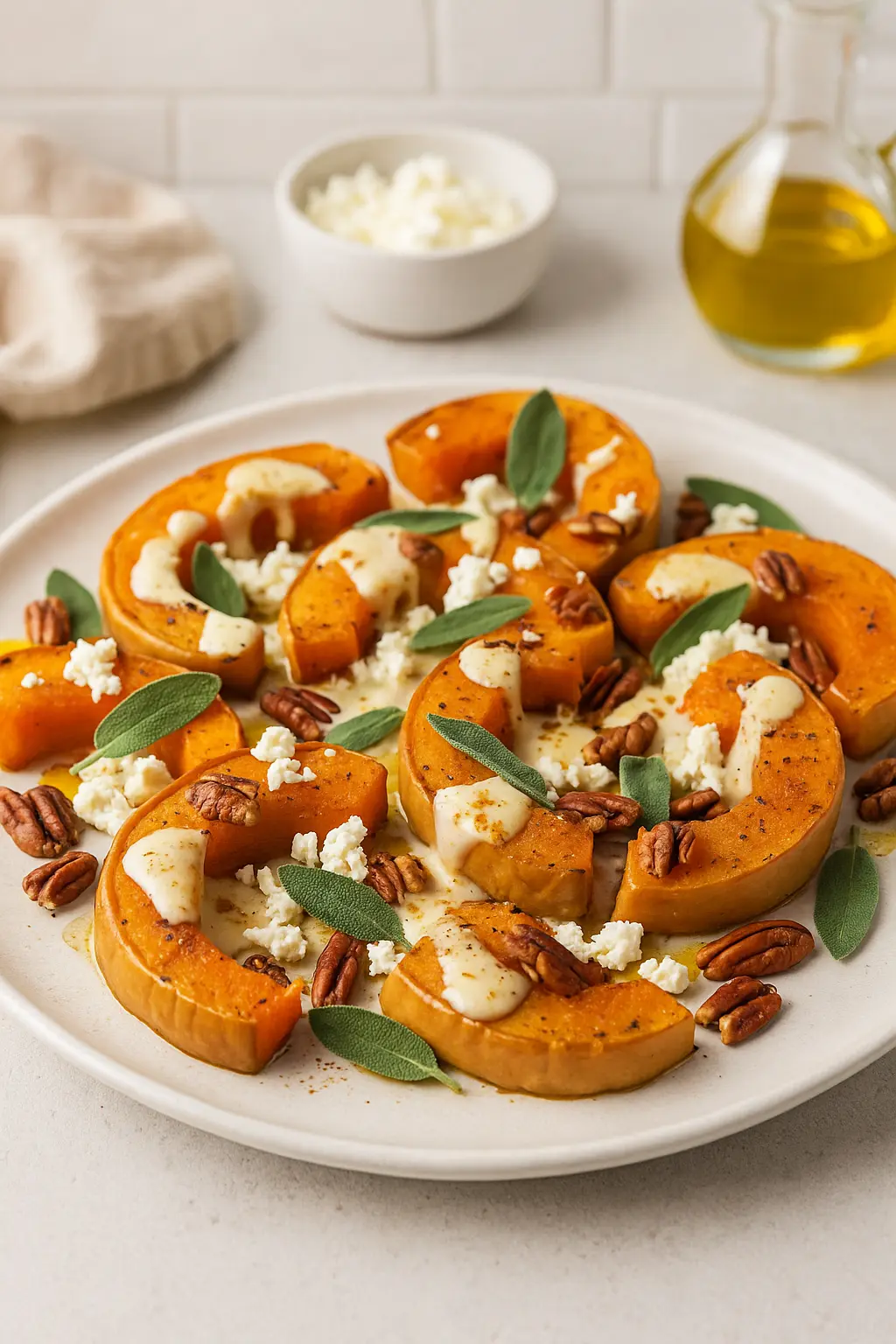
Flavor Pairing Guide
Here are some of the best flavor partners for roasted butternut squash. Use these to build your own dishes or complement other ingredients:
- Sweet: maple syrup, cinnamon, apples, cranberries
- Savory: garlic, onions, parmesan, mushrooms
- Fresh: lemon, lime, parsley, mint, arugula
- Spicy: chili flakes, curry powder, harissa, cayenne
- Crunchy: toasted seeds, pecans, pine nuts, crispy chickpeas
How to Buy and Store Butternut Squash
Choosing the right squash is the first step in making great roasted butternut squash. Look for a squash that feels heavy for its size and has a matte, tan skin. Avoid any with bruises or soft spots.
You can store a whole butternut squash in a cool, dark pantry for up to a month. Once peeled and cut, keep it in the refrigerator for up to 5 days. You can also freeze cubed raw squash for up to 3 months. Thaw overnight in the fridge before roasting.
How to Peel Butternut Squash Easily
Peeling butternut squash can be tricky if you don’t have the right technique. Here’s a step-by-step method to make it easier:
- Cut off both ends of the squash so it stands flat on your cutting board.
- Microwave it for 30 seconds to loosen the skin slightly.
- Use a sharp Y-peeler and work from top to bottom in long strokes.
- Once peeled, slice in half and scoop out the seeds using a spoon.
Common Questions About Roasted Butternut Squash
How do you spice up butternut squash soup?
You can add spices like curry powder, smoked paprika, cinnamon, nutmeg, or cayenne pepper to make the soup more vibrant. A swirl of coconut milk, cream, or chili oil also adds depth and excitement.
Which spice goes with butternut squash?
Butternut squash pairs well with warm spices such as cinnamon, nutmeg, ginger, cumin, turmeric, and curry powder. Herbs like sage, thyme, and rosemary are also excellent choices.
How to make butternut squash soup more flavorful?
To boost flavor, roast the squash before blending to bring out its natural sweetness. You can also add sautéed onions, garlic, or leeks for depth. A splash of cream, coconut milk, or broth reduction makes the soup richer, while toppings like toasted seeds or cheese add contrast.
What meat goes well with butternut squash soup?
This soup pairs beautifully with roasted chicken, turkey, or duck. Crispy bacon or pancetta makes a savory topping, while sausage or ham can be mixed in for extra heartiness.
Do you put cumin in butternut squash soup?
Yes, cumin works very well in butternut squash soup. It adds a warm, earthy flavor that balances the natural sweetness of the squash.
Should I add lemon to butternut squash soup?
Yes, but in moderation. A small squeeze of lemon or a dash of lemon zest can brighten the flavors. Do not add too much or it may overpower the soup.
What does butternut squash do for the gut?
Butternut squash is rich in dietary fiber, which supports healthy digestion and regular bowel movements. It also contains antioxidants and vitamins that promote gut health.
How does Gordon Ramsay cook butternut squash?
Gordon Ramsay often roasts butternut squash with olive oil, salt, and pepper to enhance its sweetness. He then uses it for soups, risottos, or as a puree served with meats.
Why does my butternut squash soup taste bitter?
A bitter taste can come from under-ripe or overripe squash. It can also happen if the squash skin or seeds are included. Balancing with sweetness from carrots, apples, honey, or a splash of cream helps remove bitterness.

